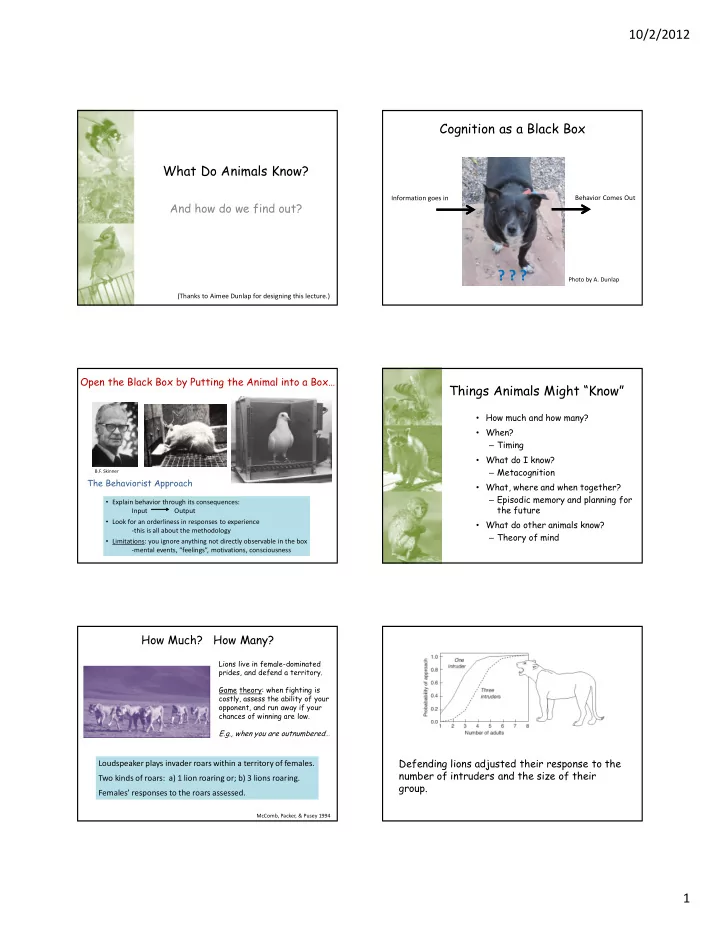

10/2/2012 Cognition as a Black Box What Do Animals Know? Information goes in Behavior Comes Out And how do we find out? ? ? ? Photo by A. Dunlap (Thanks to Aimee Dunlap for designing this lecture.) Open the Black Box by Putting the Animal into a Box… Things Animals Might “Know” � How much and how many? � When? � Timing � What do I know? � Metacognition B.F. Skinner The Behaviorist Approach � What, where and when together? � Episodic memory and planning for � Explain behavior through its consequences: the future Input Output � Look for an orderliness in responses to experience � What do other animals know? -this is all about the methodology � Theory of mind � Limitations: you ignore anything not directly observable in the box -mental events, “feelings”, motivations, consciousness How Much? How Many? Lions live in female,dominated prides, and defend a territory. Game theory: when fighting is costly, assess the ability of your opponent, and run away if your chances of winning are low. E.g., when you are outnumbered… Defending lions adjusted their response to the Loudspeaker plays invader roars within a territory of females. number of intruders and the size of their Two kinds of roars: a) 1 lion roaring or; b) 3 lions roaring. group. Females’ responses to the roars assessed. McComb, Packer, & Pusey 1994 1
10/2/2012 Chimpanzees defend their territory: Numerical Assessment � Go on patrol (‘parties’ range from 1,20 chimps) � Will attack and kill chimps from other groups What might be the upper � Territory boundaries shift as larger groups fight for more land limit of this kind of � Some groups are obliterated assessment? How many roars can you tell apart? Are they actually counting? Mike Wilson and colleagues did playback experiments: Groups of only females or of 1,2 males quietly leave. Groups of ≥3 males quickly approach the speaker. What is the difference between how Males move faster the more they outnumber the intruders. much and how many? A later paper “Chimpanzees and the mathematics of battle” by Wilson et al, used a square,law model to predict that males should be willing to fight a group of foreign males when they outnumber them by 1.5. A Basic Test with Peeps A Basic Test with Peeps Which group has more? Weber’s Law Describes the just noticeable difference (JND) between two stimuli as a function of their magnitude. The JND is a constant proportion across a wide range of values. Example: suppose a 10,gram weight has to be increased by .5 gram in order for a person to detect the change. Then a 20,gram weight would have to be increased by 1 gram, in order for the weight change to be detected. Weber’s Law takes effect… 2
10/2/2012 More on Numerical Competency Alex’s Sense of Number* Relative Numerousness Discrimination Judgments of more or less Rats, monkeys, birds, and small children can all solve these tasks. When large amounts presented, mistakes follow Weber’s Law. Alex gave English language Absolute Number Discrimination assignments of number to arrays of objects. E.g., always choose 5 Learning to pick food container with specific number of markings; turn in a maze based on the number of whisker touches, learning to peck a fixed 80% accuracy was unaffected number of times. by array quantity, or object Concept of Number & Counting mass and shape. 10 is twice as much as 5, but half as much as 20 Alex, an African Grey Parrot Chimpanzees and Alex the parrot are able to learn number symbols. Chimpanzees may even be able to add simple numbers. * work of Irene Pepperberg ������������������������������������������������ 1. seeing array of intermixed subsets of four, five, and six objects “How many blue?” 2. hearing a question “How many block?” 3. translating phrase into search for a specific object among distractors Alex could even assign number in relation to 4. determining number categories (shape, material, color). 5. vocalizing cardinal amount How many blue block? viewed as the label such as “six” Including a concept of zero (“none”). Troubles with Alex Assignment of Number ������������������������������������������������������������������ versus �������������������������������������������������� Counting ������������������������������������������������������������������� ������������������������������������������������������������������ ��������� � Counting is a serial operation (1, 2, 3,4…). ���������!����������������������������"������������������������������� �������"�������������������!���������������� Assignment of number makes no presumption about order. ��������������������������������������������������������������������� ��������������������!������������������������������������������������� ����������#������������������������������������������������������ �����������!�����$�������������������������������������������� ���������������%�����������������&��������!����' -- from Pepperberg & Gordon 2005 3
10/2/2012 ������������������������ ������������������ A More Serious Problem? A > B > C > D > E Learn that: Alex was one bird. N=1. Then test pairings like C and E, or B and D We would like to replicate! Prediction: Animals with complex societies should be able But other birds have not done nearly so to do transitive inference. well as Alex. Monkeys can do it, pigeons cannot. But both monkeys and pigeons are social. And very different kinds of animals. The Function of Transitive Inference? Prediction: Animals with complex societies should be able In a large social group, a single to do transitive inference. individual cannot observe every possible dominance encounter. Pinyon jays can do it, scrub jays cannot. Conflict is risky: you shouldn’t fight everyone to find out. Pinyon jay How do you know where you highly social, often forming very large stand in the hierarchy? flocks of 250 or more birds Scrub jay Forage in pairs, families or small groups �������������������!�"��#���������"��������������������������������������� Can birds use transitive inference to assign relative dominance? Pinyon jays placed in chambers on either side of a chamber Two Groups of Birds: Group 1 (A>B>C) and Group 2 (1>2>3) containing a peanut in a box. Experimental: Observer Jay 3 watches B dominate 2, who 3 is Doors opened and birds show either dominance or submissive to. submission.* Control: Jay 3 watches B dominate C, who it doesn’t know. * Submission indicated by ‘beak down’ position. Paz-y-Miño et al 2004 Paz-y-Miño et al 2004 4
Recommend
More recommend